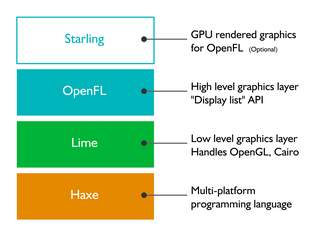
Adobe Flash is, except in China, a discontinued multimedia software platform used for production of animations, rich internet applications, desktop applications, mobile apps, mobile games, and embedded web browser video players.
SWF is a defunct Adobe Flash file format that was used for multimedia, vector graphics and ActionScript.
Adobe Flash Player is computer software for viewing multimedia content, executing rich Internet applications, and streaming audio and video content created on the Adobe Flash platform. It can run from a web browser as a browser plug-in or independently on supported devices. Originally created by FutureWave under the name FutureSplash Player, it was renamed to Macromedia Flash Player after Macromedia acquired FutureWave in 1996. It was then developed and distributed by Adobe Systems as Flash Player after Adobe acquired Macromedia in 2005. It is currently developed and distributed by Zhongcheng for users in China, and by Harman International for enterprise users outside of China, in collaboration with Adobe.

Adobe Captivate is an authoring tool that is used for creating eLearning content such as software demonstrations, software simulations, branched scenarios, and randomized quizzes in HTML5 format.

Dojo Toolkit is an open-source modular JavaScript library designed to ease the rapid development of cross-platform, JavaScript/Ajax-based applications and web sites. It was started by Alex Russell, Dylan Schiemann, David Schontzler, and others in 2004 and is dual-licensed under the modified BSD license or the Academic Free License.

Adobe AIR is a cross-platform runtime system currently developed by Harman International, in collaboration with Adobe Inc., for building desktop applications and mobile applications, programmed using Adobe Animate, ActionScript, and optionally Apache Flex. It was originally released in 2008. The runtime supports installable applications on Windows, macOS, and mobile operating systems, including Android, iOS, and BlackBerry Tablet OS.

HTML5 is a markup language used for structuring and presenting hypertext documents on the World Wide Web. It was the fifth and final major HTML version that is now a retired World Wide Web Consortium (W3C) recommendation. The current specification is known as the HTML Living Standard. It is maintained by the Web Hypertext Application Technology Working Group (WHATWG), a consortium of the major browser vendors.
This is a comparison of web frameworks for front-end web development that are heavily reliant on JavaScript code for their behavior.
Apache Cordova is a mobile application development framework created by Nitobi. Adobe Systems purchased Nitobi in 2011, rebranded it as PhoneGap, and later released an open-source version of the software called Apache Cordova. Apache Cordova enables software programmers to build hybrid web applications for mobile devices using CSS3, HTML5, and JavaScript, instead of relying on platform-specific APIs like those in Android, iOS, or Windows Phone. It enables the wrapping up of CSS, HTML, and JavaScript code depending on the platform of the device. It extends the features of HTML and JavaScript to work with the device. The resulting applications are hybrid, meaning that they are neither truly native mobile application nor purely Web-based. They are not native because all layout rendering is done via Web views instead of the platform's native UI framework. They are not Web apps because they are packaged as apps for distribution and have access to native device APIs. Mixing native and hybrid code snippets has been possible since version 1.9.

Away3D is an open-source platform for developing interactive 3D graphics for video games and applications, in Adobe Flash or HTML5. The platform consists of a 3D world editor, a 3D graphics engine, a 3D physics engine and a compressed 3D model file format (AWD).

Adobe Animate is a multimedia authoring and computer animation program developed by Adobe Inc.
Modern HTML5 has feature-parity with the now-obsolete Adobe Flash. Both include features for playing audio and video within web pages. Flash was specifically built to integrate vector graphics and light games in a web page, features that HTML5 also supports.
Adobe Edge Animate, formerly known as just Adobe Edge, is a web development tool developed by Adobe Systems that uses HTML5, JavaScript, and CSS3 functionality. It later became part of the Adobe Edge suite, and was available as a free 30-day trial download from Adobe Creative Cloud. As of November 2015, Edge Animate is no longer being actively developed.

Google Swiffy was a web-based tool developed by Google that converted SWF files to HTML5. Its main goal was to display Flash contents on devices that do not support Flash, such as iPhone, iPad, and Android Tablets. Swiffy was shut down July 1, 2016.
Ajax Animator is a free, web-based animation suite. Its development began in March 2006 by Antimatter15, then a sixth grader. Ajax Animator was originally intended to be a free replacement to Flash MX, but is now a general-purpose animation tool. Ajax Animator is primarily written using JavaScript, the Ext JS framework, and HTML5-related technologies such as SVG. The software can be used either from within a web browser or from an offline installation.

Three.js is a cross-browser JavaScript library and application programming interface (API) used to create and display animated 3D computer graphics in a web browser using WebGL. The source code is hosted in a repository on GitHub.

OpenFL is a free and open-source software framework and platform for the creation of multi-platform applications and video games. OpenFL applications can be written in Haxe, JavaScript, or TypeScript, and may be published as standalone applications for several targets including iOS, Android, HTML5, Windows, macOS, Linux, WebAssembly, Flash, AIR, PlayStation 4, PlayStation 3, PlayStation Vita, Xbox One, Wii U, TiVo, Raspberry Pi, and Node.js.

Phaser is a 2D game framework used for making HTML5 games for desktop and mobile. It is free software developed by Photon Storm.

Boxy SVG is a vector graphics editor for creating illustrations, as well as logos, icons, and other elements of graphic design. It is primarily focused on editing drawings in the SVG file format. The program is available as both a web app and a desktop application for Windows, macOS, ChromeOS, and Linux-based operating systems.









